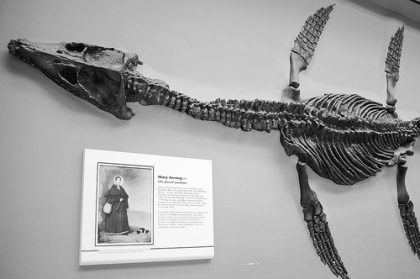
 )
)This post discusses plot details of Ammonite which is based on the life of Mary Anning while admittedly also employing significant creative license. To the extent such a film can be spoiled, this post contains spoilers.
We haven’t talked about a movie in a while, and since I’ve written before about Mary Anning, it seemed appropriate to discuss the recent film Ammonite based on her life. I knew very little about the film beyond the fact that Anning was its subject, but I was expecting something akin to The Dig, a drama centered around an unlikely archaeological find. And indeed both films feature plenty of English mud. But where The Dig, well, delved into the politics of the early 20th century British archaeology world and the broader significance of the titular excavation, Ammonite is much more interested in the personal life of Anning (including several explicit sex scenes that may be disqualifying for prospective viewers).
To be fair, Anning does spend much of the film working, either collecting fossils along the coast or cleaning and polishing them in her home. Her role in discovering the first ichthyosaur skeleton is mentioned. In one scene, she speaks knowledgeably about coprolites. But none of these science details are given any context. For example, if you didn’t know she was central to realizing the true nature of coprolites, the film isn’t going to help you and that scene might come across as simply scatological comic relief. With respect to science, I guess I’d say that what the film does best is get across how strenuous, painstaking, and monotonous science can be. But given how miserable Anning seems to be for most of the film and without a real appreciation for the significance of her contributions, you’d be forgiven for wondering why anyone would bother.
The only thing that brings Anning happiness in the film is her relationship with Charlotte Murchison. Murchison was a geologist in her own right prior to meeting Anning, although in this version she’s so detached when first introduced she seems barely aware of the world around her, let alone interested or knowledgeable. The film speculates the two had an affair (Murchison was married to fellow geologist Roderick) that feels like something more than a tryst but less than a romance. A shared interest in science may have brought the two together in real life, but since the film has little time for science, what’s left of the relationship seems primarily physical. Or perhaps I just didn’t know how to properly read the intervening silences.
I understand that same-sex relationships are underrepresented in our depictions of the past, especially of eras in which such relationships were illicit. If Anning and Murchison had the kind of relationship the film depicts, there may not have been a record of it out of necessity. So I can appreciate why an argument from silence may be particularly underwhelming in cases like these. Thematically, that’s a dilemma I imagine paleontologists like Anning can appreciate. Fossils offer a very limited picture of bygone eras. Mainly skeletons only are preserved, and then only of organisms that died in just the right circumstances. As a result, the fossil record is biased. We can identify those biases, but we cannot always fully correct for them. Sometimes the best we can do to fill in the blanks about soft tissues or behaviors are unverifiable hypotheses. Likewise no life leaves behind a full record, and so historians and biographers have to deal with gaps as well.
While this metatextual resonance exists, I’m not sure the film took advantage of the opportunity to express it. To do so, the film would have to engage with Anning’s and Murchison’s science more completely. As I noted, we see the physicality of it, but not the intellectual dimension. Yes, paleontology involves plenty of digging, rock-splitting, brushing and the like, and it also involves inquiry and inferences and insights. If we saw more of that side of the science, perhaps we might better appreciate why the life of a paleontologist seems especially apt for extrapolating about what wasn’t preserved. After all, a good hypothesis does not merely substitute for where we have no data; a good hypothesis also reckons with the full array of available facts.
Interested in science communication? Don’t miss Monday’s announcement of a science & faith communication job opportunity with the American Scientific Affiliation!
Andy has worn many hats in his life. He knows this is a dreadfully clichéd notion, but since it is also literally true he uses it anyway. Among his current metaphorical hats: husband of one wife, father of two teenagers, reader of science fiction and science fact, enthusiast of contemporary symphonic music, and chief science officer. Previous metaphorical hats include: comp bio postdoc, molecular biology grad student, InterVarsity chapter president (that one came with a literal hat), music store clerk, house painter, and mosquito trapper. Among his more unique literal hats: British bobby, captain’s hats (of varying levels of authenticity) of several specific vessels, a deerstalker from 221B Baker St, and a railroad engineer’s cap. His monthly Science in Review is drawn from his weekly Science Corner posts — Wednesdays, 8am (Eastern) on the Emerging Scholars Network Blog. His book Faith across the Multiverse is available from Hendrickson.

Leave a Reply